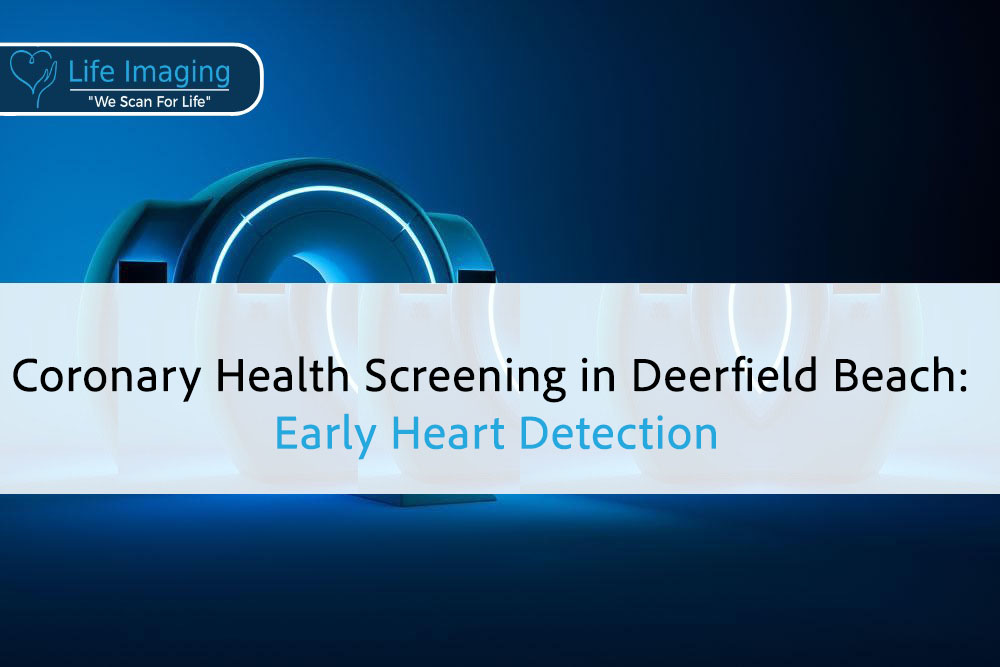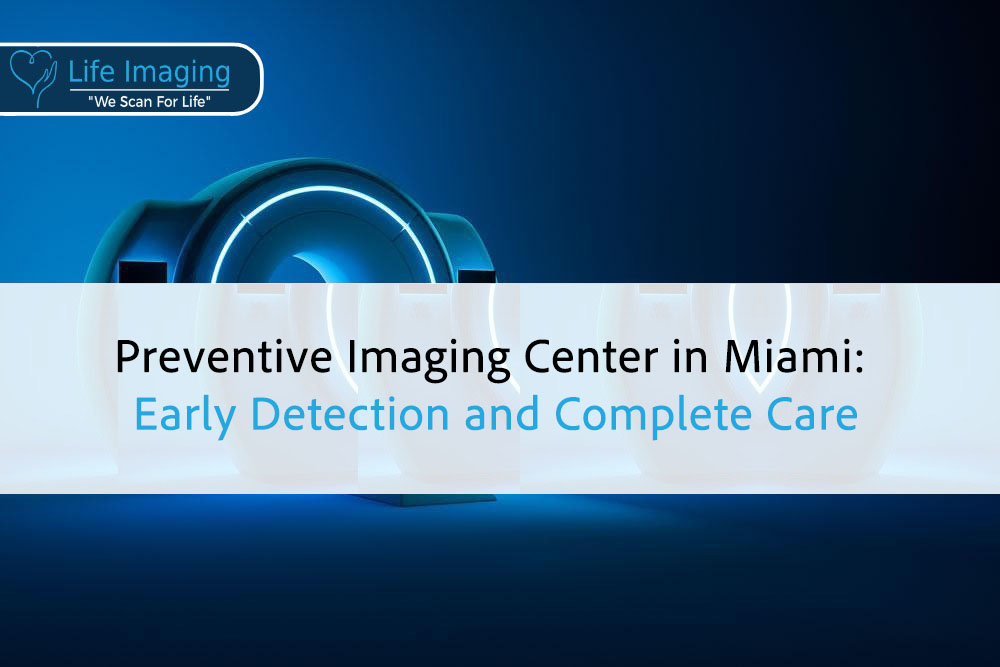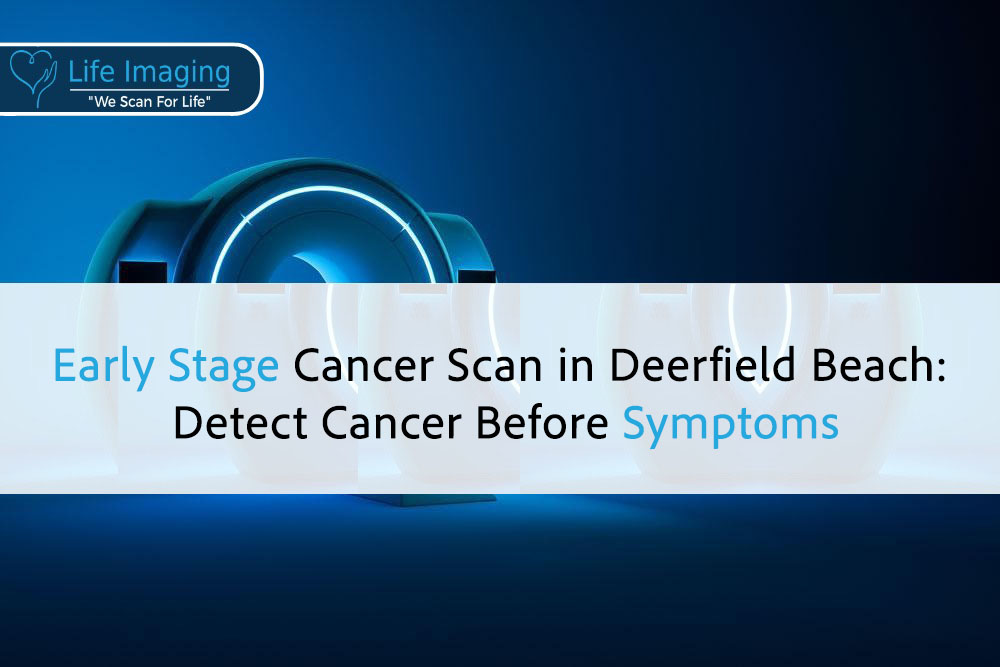
Coronary Artery Scan Near Me in Jupiter: Early Heart Health Detection
Introduction Your heart works hard every second of the day,

Prostate cancer is one of the most common cancers affecting men today. Early detection is crucial for successful treatment and better outcomes. The earlier prostate cancer is detected, the more effective the treatment options available. Fortunately, residents of Orlando have access to advanced imaging services and early detection methods that can make a significant difference in diagnosing prostate cancer at an early stage.
At Life Imaging Fla, an imaging center for early detection of heart disease and cancer, we understand the importance of early screening. Offering a range of cutting-edge imaging techniques, Life Imaging Fla aims to provide accurate and timely results to aid in early diagnosis and treatment planning. This comprehensive guide will delve into the early detection methods for prostate cancer, highlighting the importance of regular screenings and how these methods can improve the chances of successful treatment.
We’ll explore various screening techniques, such as PSA testing, digital rectal exams, and advanced imaging technologies. Each method offers unique benefits and can be crucial in the early identification of prostate cancer. Understanding these methods can help you make informed decisions about your health. Early detection is a pivotal step in the fight against prostate cancer, and Life Imaging Fla is dedicated to providing the best diagnostic tools to support this cause.
Stay with us as we walk through the essential early detection methods for prostate cancer available in Orlando, emphasizing why early detection matters and how it can save lives.
Understanding prostate cancer is vital for recognizing the importance of early detection. Prostate cancer starts in the prostate gland, a small walnut-shaped gland in men that produces seminal fluid. This cancer is one of the most common types affecting men, particularly older men. Early stages of prostate cancer may not cause any symptoms, making regular screenings critical for early identification and treatment.
Prostate cancer can grow slowly or aggressively. Slow-growing prostate cancers may need minimal or even no treatment, while aggressive forms can spread quickly and require more immediate attention. Knowing the type of prostate cancer you’re dealing with helps doctors decide the best course of treatment.
Early detection of prostate cancer significantly increases the chances of effective treatment and can save lives. When caught early, prostate cancer is more likely to be confined to the prostate gland, where it may be easier to treat. Screening tests can find prostate cancer before symptoms begin, allowing for early intervention.
Regular screenings can also help monitor prostate health and detect any changes over time. This monitoring is especially important for men with higher risk factors, such as a family history of prostate cancer, being African American, or having certain genetic mutations. Understanding your risk and keeping up with regular screenings can make a big difference in outcomes.
PSA testing is one of the most common methods for early detection of prostate cancer. PSA stands for Prostate-Specific Antigen, a protein made by the prostate gland. PSA testing measures the level of this protein in the blood. Elevated PSA levels can indicate the presence of prostate cancer, but high levels can also be due to other conditions, such as an enlarged prostate or inflammation.
A simple blood test is used to measure PSA levels. Men with higher PSA levels may need further tests to determine the cause. Your doctor will consider factors like age and prostate size when interpreting PSA test results. While PSA testing is a useful tool, it’s not definitive on its own. It’s often used alongside other tests to provide a clearer picture of prostate health.
The Digital Rectal Exam (DRE) is another important screening method for prostate cancer. During a DRE, a doctor inserts a gloved, lubricated finger into the rectum to check the size, shape, and texture of the prostate gland. This exam helps detect abnormalities that could indicate prostate cancer.
DREs are usually quick and are performed during regular check-ups. Although they may be slightly uncomfortable, they provide valuable information about the prostate. Combining DRE results with PSA test results gives doctors a more comprehensive assessment of prostate health.
Advanced imaging techniques play a crucial role in the early detection and diagnosis of prostate cancer. These imaging methods provide detailed pictures of the prostate and surrounding areas, helping doctors pinpoint any abnormalities.
Magnetic Resonance Imaging (MRI) is a powerful tool for detecting prostate cancer. MRI uses strong magnetic fields and radio waves to produce detailed images of the prostate gland. This method can help identify suspicious areas that might need further investigation.
A special type of MRI called multiparametric MRI (mpMRI) combines different imaging techniques to provide even more detailed pictures. MpMRI allows doctors to differentiate between harmless and potentially cancerous tissue more accurately.
Computed Tomography (CT) scans are another advanced imaging method used in prostate cancer detection. CT scans use X-rays to create detailed cross-sectional images of the body, including the prostate gland. These scans can help detect the spread of prostate cancer to other parts of the body, such as the lymph nodes or bones.
Genetic testing has become an important tool in understanding the risk of prostate cancer. By analyzing genes, doctors can identify mutations that increase the likelihood of developing prostate cancer. Men with certain genetic mutations, like BRCA1 and BRCA2, are at a higher risk for aggressive forms of prostate cancer.
Genetic testing involves a simple blood test or saliva sample. The results can guide personalized screening and prevention strategies. Knowing your genetic risk helps you make informed decisions about regular screenings and lifestyle choices to reduce your cancer risk.
A biopsy is a definitive test for diagnosing prostate cancer. If other screening tests suggest the presence of prostate cancer, a biopsy may be performed to confirm the diagnosis. During a biopsy, small samples of prostate tissue are taken and analyzed under a microscope to check for cancer cells.
There are different types of prostate biopsies, including transrectal ultrasound-guided biopsy, where a probe is inserted into the rectum to guide needle insertion into the prostate. The procedure is usually done under local anesthesia and is relatively quick.
Understanding the risk factors for prostate cancer is essential for deciding when to start screenings. Age is a significant risk factor – men over 50 are at higher risk. Family history also plays a role; a man with a father or brother who has prostate cancer is more likely to develop it himself.
Race and ethnicity can influence the risk, too. African American men are more likely to develop prostate cancer and have higher mortality rates than men of other races. Genetic mutations, as mentioned earlier, are also important risk factors.
While some risk factors are out of your control, lifestyle choices can influence your risk of developing prostate cancer. Maintaining a healthy diet, staying physically active, and avoiding smoking can reduce your risk. Eating foods rich in antioxidants, such as fruits and vegetables, can also support prostate health.
Regular screenings and paying attention to any changes in your health can help with early detection. Discussing your risk factors with your doctor can guide personalized screening schedules and preventive measures.
Combining different screening methods provides the most accurate assessment of prostate health. PSA tests, DREs, advanced imaging, and biopsies each offer unique insights. Together, they create a comprehensive approach to detecting prostate cancer early.
Your doctor will recommend a combination of tests based on your risk factors and health condition. Regular monitoring and combining screening methods increase the chances of catching prostate cancer early, improving treatment outcomes.
Taking an active role in your prostate health is essential. By understanding the various early detection methods and staying informed about your risk factors, you can work with your healthcare provider to create a screening plan that’s right for you. Early detection of prostate cancer can save lives and improve your quality of life, making it an important focus for men’s health in Orlando.
Active surveillance is an approach used for managing prostate cancer that appears to be growing slowly. Instead of immediate treatment, doctors monitor the cancer with regular check-ups and tests. This method is often chosen for older men or those with other health conditions, as the risks and side effects of treatment may outweigh the benefits.
Active surveillance involves regular PSA tests, digital rectal exams (DRE), and occasional biopsies. These tests track any changes in the prostate and help doctors decide if and when treatment should begin. The goal is to avoid unnecessary treatments while keeping a close eye on the cancer.
Active surveillance allows men to maintain their quality of life by avoiding the side effects of treatments like surgery and radiation. It’s a good option for those with low-risk prostate cancer that’s not causing symptoms. This approach also reduces the risk of overtreatment, ensuring treatment is only given when necessary.
While active surveillance can delay or avoid the need for treatment, it requires frequent follow-up tests and appointments. For some, the anxiety of living with untreated cancer can be stressful. There’s also a small risk that the cancer could grow or spread between check-ups, making treatment more challenging.
If tests show that prostate cancer is growing or becoming more aggressive, doctors may recommend moving from active surveillance to active treatment. Treatment options can include surgery, radiation therapy, hormone therapy, or a combination of these. The choice of treatment depends on several factors, including the stage and grade of the cancer and the patient’s overall health.
One common treatment for prostate cancer is prostatectomy, which is the surgical removal of the prostate gland. This procedure is often recommended for localized prostate cancer, meaning cancer that hasn’t spread outside the prostate.
There are different types of prostatectomies, including open, laparoscopic, and robotic-assisted surgery. Open prostatectomy involves a larger incision, while laparoscopic and robotic-assisted surgeries are minimally invasive and use smaller incisions. Robotic-assisted surgery uses robotic arms controlled by the surgeon for more precision.
Prostatectomy can effectively remove localized cancer and has a high success rate for preventing recurrence. However, like any surgery, it comes with risks such as infection, bleeding, and complications related to anesthesia. Long-term side effects can include urinary incontinence and erectile dysfunction.
Radiation therapy uses high-energy rays to kill cancer cells. It’s another common treatment for prostate cancer and can be used alone or in combination with other treatments.
There are two main types of radiation therapy: external beam radiation therapy (EBRT) and brachytherapy. EBRT involves targeting the prostate with radiation from a machine outside the body, usually over several weeks. Brachytherapy places radioactive seeds directly into the prostate, delivering radiation over a longer period.
Radiation therapy can be highly effective at treating localized prostate cancer. It’s less invasive than surgery and can be a good option for older men or those with other health conditions. However, it can cause side effects like fatigue, skin irritation, urinary problems, and bowel issues.
Hormone therapy, also called androgen deprivation therapy (ADT), reduces the levels of male hormones (androgens) in the body to slow the growth of prostate cancer. Androgens like testosterone can fuel the growth of prostate cancer cells.
Hormone therapy can be achieved through medications that lower androgen levels or block their effects or through surgery to remove the testicles (orchiectomy), which produce most of the body’s testosterone. Medications include luteinizing hormone-releasing hormone (LHRH) agonists and antagonists, as well as anti-androgens.
Hormone therapy can be effective for advanced or recurrent prostate cancer, often in combination with other treatments. It’s useful for shrinking tumors and slowing cancer growth. The side effects can include hot flashes, reduced libido, fatigue, and loss of bone density.
For many men, the most effective approach may be combining different treatments. Your doctor might recommend a combination of surgery, radiation, and hormone therapy, depending on your specific case. Combining treatments can increase the chances of successful outcomes but also involves managing a wider range of side effects.
After initial prostate cancer treatment, regular follow-ups are crucial. These follow-ups usually involve PSA tests, imaging tests, and physical exams to monitor for any signs of cancer returning. Consistent monitoring helps catch recurrences early, making additional treatments more effective.
Managing prostate cancer often requires a multidisciplinary team of healthcare professionals. This team can include urologists, oncologists, radiologists, and other specialists who work together to create a comprehensive treatment plan. The team approach ensures that all aspects of your health and well-being are considered in your care.
Coping with prostate cancer can be challenging, but various support and resources are available to help. Support groups, counseling services, and patient education programs provide emotional support and practical advice. These resources can help patients and their families navigate the complexities of cancer treatment and recovery.
Good nutrition plays an important role in cancer treatment and recovery. Eating a balanced diet can help manage treatment side effects, improve energy levels, and support overall health. Nutritional counseling from a registered dietitian can help create a diet plan tailored to your needs and preferences.
Staying physically active during and after prostate cancer treatment can offer several benefits. Exercise helps manage fatigue, improve mood, and maintain muscle strength. It’s important to find an activity level that’s comfortable and safe for you. Always consult your doctor before starting a new exercise program.
Managing the side effects of prostate cancer treatments is an important part of your care plan. Side effects can vary depending on the treatment type and individual response. They can include urinary problems, bowel issues, sexual dysfunction, and emotional challenges.
Several strategies can help manage treatment side effects. Medications can address specific issues like pain or nausea. Pelvic floor exercises can help improve urinary continence, while counseling and support groups can provide emotional support. Communicating openly with your healthcare team about any side effects you’re experiencing is key to finding effective solutions.
Research in prostate cancer is ongoing, leading to advances in early detection, treatment, and management. New imaging techniques, genetic tests, and treatments are continuously being developed to improve outcomes for men with prostate cancer.
Clinical trials play a crucial role in advancing prostate cancer research. These trials test new treatments and approaches to find better ways to detect and treat prostate cancer. Participating in a clinical trial can provide access to cutting-edge treatments and contribute to important scientific advancements. Always discuss the potential benefits and risks of participating in a clinical trial with your healthcare provider.
The long-term outlook for men with prostate cancer varies based on several factors, including the stage and grade of cancer at diagnosis, the chosen treatment plan, and overall health. Early detection and advances in treatment have significantly improved the prognosis for many men with prostate cancer. Regular follow-ups and a focus on healthy lifestyle choices can support long-term health and well-being.
Understanding the comprehensive approach to prostate cancer management highlights the importance of early detection and regular monitoring. By staying informed and proactive about your prostate health, you can work with your healthcare team to make the best decisions for your individual needs.
Lifestyle changes can play a significant role in maintaining prostate health and potentially lowering the risk of prostate cancer. Certain habits and choices can make a difference in your overall well-being.
A healthy diet is important for prostate health. Eating plenty of fruits and vegetables, whole grains, lean proteins, and healthy fats can support your body’s functions. Foods high in antioxidants, such as berries and leafy greens, can be beneficial for reducing inflammation and protecting against cancer.
Consider adding foods like tomatoes, which contain lycopene, a powerful antioxidant. Broccoli, green tea, and nuts are also great choices. Omega-3 fatty acids found in fish like salmon can help reduce inflammation. Including soy products might also be beneficial due to their isoflavones.
It can help to limit red and processed meats, high-fat dairy products, and foods high in sugar. These types of foods might contribute to inflammation and other health issues. Reducing alcohol intake and avoiding tobacco use can also positively impact your prostate health.
Staying active is important for overall health and can help in managing weight, reducing stress, and improving mood. Physical activity can positively affect hormone levels and reduce the risk of developing cancer.
Incorporate a mix of aerobic exercises, like walking and swimming, with strength training exercises. Activities like cycling, jogging, or even dancing can be fun ways to stay active. Aim for at least 30 minutes of moderate exercise most days of the week.
Chronic stress can negatively impact your health, including your prostate. Learning how to manage stress is a key component of maintaining overall well-being.
Practice relaxation techniques like deep breathing, meditation, or yoga. These activities can help you stay calm and focused. Regular physical activity, as mentioned earlier, also helps reduce stress. Ensuring adequate sleep and spending time with loved ones can further enhance your stress management efforts.
Drinking enough water is essential for keeping your body functioning properly. Adequate hydration can help flush out toxins and support overall health.
Aim to drink at least eight 8-ounce glasses of water daily. Staying hydrated is important, especially if you are physically active or live in a hot climate like Orlando. Listen to your body and drink more if you feel thirsty.
Understanding the stages of prostate cancer helps in determining the best treatment plan. Prostate cancer is typically classified into several stages based on the size of the tumor and whether the cancer has spread.
Stage I
In Stage I, the cancer is small and confined to the prostate. At this stage, the cancer is usually not aggressive, and treatments can be very effective. Active surveillance might be an option for some patients.
Stage II
Stage II cancer is still confined to the prostate but is larger and may be detected through a Digital Rectal Exam. Treatment options might include surgery or radiation therapy, especially if the cancer is more aggressive.
Stage III
In Stage III, the cancer has spread beyond the prostate to nearby tissues. More aggressive treatment options, including a combination of surgery, radiation, and hormone therapy, may be required.
Stage IV
Stage IV cancer has spread to distant parts of the body, such as the lymph nodes, bones, or other organs. Treatment at this stage focuses on controlling the spread and managing symptoms. Options might include chemotherapy, advanced hormone therapies, and targeted therapy.
Advances in imaging technology have significantly improved the detection and management of prostate cancer. New techniques offer more detailed images and can help identify cancer earlier.
MRI, particularly multiparametric MRI, has become a valuable tool in prostate cancer diagnosis. It can provide detailed images of the prostate and surrounding tissues, helping to identify suspicious areas that might need a biopsy. This type of imaging can also help guide biopsies to ensure samples are taken from the most relevant areas.
Positron Emission Tomography (PET) scans are another advanced imaging technique. PET scans can detect cancer cells throughout the body and are often combined with CT scans to provide a more comprehensive view. This is particularly useful in assessing whether prostate cancer has spread beyond the prostate.
Ultrasound is commonly used in prostate cancer diagnosis, particularly transrectal ultrasound (TRUS). TRUS involves inserting a small probe into the rectum to obtain images of the prostate. This method is often used to guide prostate biopsies and assess the size and shape of the gland.
Innovations in biopsy techniques are improving the accuracy of prostate cancer diagnosis. These methods ensure that tissue samples are taken from the most likely areas of concern.
Fusion biopsy combines MRI and ultrasound images to guide the biopsy needle more accurately. By overlaying MRI images with real-time ultrasound, doctors can target suspicious areas with greater precision, increasing the likelihood of detecting cancer.
Liquid biopsies are a newer, less invasive technique that analyzes cancer-related markers in the blood. While still being researched, liquid biopsies have the potential to detect prostate cancer earlier and monitor its progression without the need for traditional tissue biopsies.
Knowing when to see a doctor is important for maintaining prostate health. Regular check-ups and screenings can help catch potential problems early.
Common symptoms of prostate issues include difficulty urinating, frequent urination, pain or burning during urination, blood in urine or semen, and difficulty achieving an erection. If you experience any of these symptoms, consult your doctor promptly.
Regular screenings are important for early detection of prostate cancer, especially for those at higher risk. Discuss with your doctor when to start screenings based on your age, family history, and personal risk factors.
Having a good relationship with your doctor helps ensure you get the best care possible. Open communication allows you to discuss concerns, ask questions, and make informed decisions about your health.
Preparing for your appointments can help you make the most of your time with your doctor. Jot down any questions or symptoms you’ve noticed, and bring a list of medications you’re taking. This preparation ensures you cover all your concerns during the visit.
Working together with your healthcare provider is key to maintaining your prostate health. Regular screenings, staying informed about risk factors, and making healthy lifestyle choices can contribute to better outcomes. By understanding the stages of prostate cancer and the latest advances in detection and treatment, you can take proactive steps to manage your health effectively.
Proactive Prostate Health Management
Proactive management of prostate health is crucial for early detection and effective treatment of prostate cancer. By understanding the importance of regular screenings, knowing the stages of prostate cancer, and staying informed about the latest diagnostic techniques and treatments, you can take charge of your health. Combining healthy lifestyle choices with advanced medical care provides the best chance for maintaining overall well-being.
It’s important to engage in open conversations with your healthcare provider and adhere to recommended screening schedules, especially if you’re at higher risk due to age, family history, or other factors. Staying vigilant about any changes or symptoms can lead to early diagnosis and more successful treatment outcomes.
Advanced imaging techniques like MRI, PET scans, and innovative biopsy methods are making prostate cancer diagnosis more accurate and less invasive. These technologies enhance the ability to detect cancer in its early stages, paving the way for personalized treatment plans that cater to individual needs.
For residents of Orlando, seeking timely and comprehensive cancer tests can significantly impact long-term health. Implementing dietary changes, maintaining an active lifestyle, managing stress, and staying hydrated are all simple yet effective steps toward better prostate health.
Don’t

Introduction Your heart works hard every second of the day,

Introduction Your heart works around the clock, but changes inside

Introduction Your heart works nonstop, often without a single complaint.

Introduction The best part of getting older is having time

Introduction Good health isn’t just about treating problems, it’s about

Introduction Cancer often begins quietly, long before you feel anything

* Get your free heart scan by confirming a few minimum requirements.
Our team will verify that you qualify before your scan is booked.
Copyright © 2025 Life Imaging – All Rights Reserved